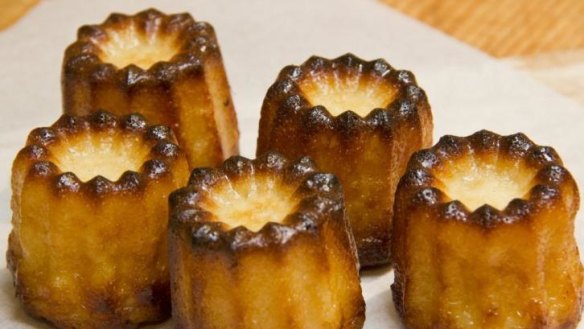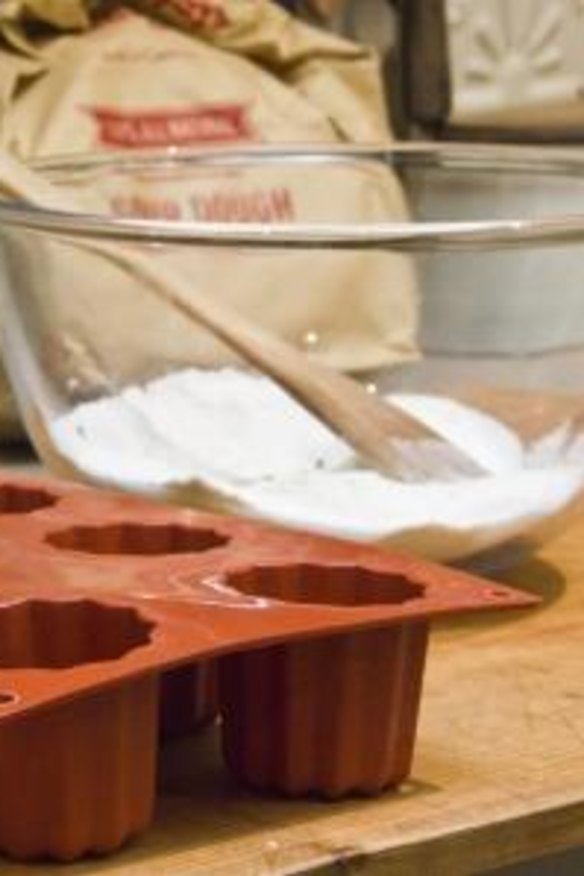Canele recipe that breaks the mould

Despite their size, these little pastries are surrounded by much tradition, myth and misconception. This mystery not only relates to their provenance but the mistaken believe that great patisserie skills are needed to produce a perfect pastry confection. Seriously, if you can cook pancakes, you can cook caneles.
As far as their origin goes, holding Google up as your reference source, they hail from somewhere in France, particularly Bordeaux. This information is highly dependent on which page of research you stumble upon but if you are wandering around the Bordeaux area of France, you cannot miss the plentiful supply of these cakes sold everywhere.
The other controversy surrounding the canele is which cooking receptacle provides the best result. Canele traditionalists, and there is such a group, claim the little French copper moulds produce perfection, and I would agree with this. If you are going to go to the trouble of sourcing and using the copper canele moulds, then you would probably go to the extent of coating each mould with organic edible beeswax prior to baking. I agree this sounds a bit extreme, but it is fully traditional and gives the canele its crispy exterior.

However, the much more economically priced silicone moulds still produce an excellent canele with the mandatory crispy exterior and molten interior without the need to use beeswax or copper. The canele moulds are easily purchased on Ebay or Amazon for well under $15. The result is a little more rustic, but not discernibly different.
If you plug "canele" into Google, you will see there is a significant amount of discourse about the difficulties of making these pastries and they are the subject of numerous blogs that wax lyrical about methods and equipment. I have made these gorgeous little cakes a number of times and haven’t experienced any failures using the silicone moulds and the following recipe.
Caneles are delicious warm or cold and keep for a few days in an airtight container in the fridge. They are usually quickly eaten, but if you have any left, they can be warmed for 10 seconds in the microwave oven to freshen up.
They can be eaten warm or cool, and keep for a few days in an airtight container in the fridge. My favourite is warm, where the outside is crispy and the inside is soft and a little molten.
This mixture produces about 20 caneles and the mixture should be left at least 24 hours in the fridge before baking. If baking for kids, leave out the rum in the recipe below.
Caneles
2 cups whole milk
30g unsalted butter
1 tsp vanilla paste
100g plain flour, sifted
1 tsp sea salt
180g sugar
3 eggs
80ml good quality rum
Combine the milk, butter and vanilla in a medium saucepan and bring to a simmer. In the meantime, combine the sifted flour, salt and sugar in a mixing bowl. Break the eggs into a small bowl and beat gently without incorporating any air. When the milk mixture starts to simmer, remove from the heat and set it aside.
Pour the eggs all at once into the flour then, immediately after, pour the milk mixture into the flour, stirring with a wooden spoon or spatula until well combined. Do not whisk as you do not want to incorporate air. Add the rum and stir. Let the mixture cool to room temperature, then cover and refrigerate for at least 24 hours or up to three days. The longer this mixture is left the better the flavour.
When ready to bake, preheat the oven to a very hot 250C. Lightly grease the canele moulds with melted butter. Remove the batter from the fridge and stir to incorporate the liquids that may have separated. Do not whisk.
If using a silicone mould, place the mould onto an oven tray for ease of handling. Fill each mould almost to the top with the batter and put into the oven to bake for 20 minutes. After 20 minutes, reduce the temperature to 200C and place a piece of silicone baking paper on top of the caneles to stop them from burning. Bake for a further 20 minutes. The tops of the caneles should be a dark golden colour.
Remove from the oven and leave for about 15 minutes before unmoulding the caneles onto a cooling rack. They should drop out easily from their moulds and as they cool further, will collapse only very slightly.
Appears in these collections
The best recipes from Australia's leading chefs straight to your inbox.
Sign up